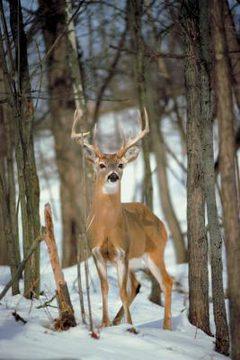Why Whitetails May Or May Not Move

Whitetail deer have mastered the skills of survival. They have incredible senses and quickly learn how to avoid danger. There are many reasons deer stay in bed on any given day, learning more about why and when they may decide to stay put can help you become a more successful hunter.
Weather can have a strong influence on deer movement. On days where the wind is blowing above 10mph deer movement seems to slow drastically. Of course if 15mph winds are normal for your area, this will have little effect on deer movement. Here in Maryland there are many days with little to no wind. So when the wind does kick up, I believe the noise and movements all around keep deer in their beds longer.
Barometric pressure can also be a good predictor of deer movement. When the barometric pressure rises or falls quickly, as it does before and after a storm, this can trigger deer to move and feed. Some studies indicate that the greatest level of deer activity occurs when the barometric pressure is between 29.80 and 30.29. Being on-stand right before a storm can certainly prove to be a great time for whitetail sightings.
Unseasonable temperatures can also have big influences on whitetail movements. If the temperatures exceed 12 to 15 degrees higher then the normal highs in your area, this can grind deer movement to a halt, especially during the fall and winter. Whitetails will have their winter coats by this time and high temperatures can make it uncomfortable to do much more then bed on a shady hillside or thick cover.
Just like Humans, whitetails all have individual personalities and make decisions based on likes and dislikes. Some whitetails are very sociable and curious, while others like to keep their distance and be left alone. You can imagine which whitetails you tend to see from your treestand the most. Personality can have a great effect on a specific deer on your property. If the buck you’ve been watching all summer is a loner (and a lot of big bucks are) that is going to make him all the much harder to get close to. If the buck your chasing is very aggressive and confrontational then he may be easier to dupe with calls or decoys. Observing and watching how the deer move and interact with each other are the only way to learn these traits, and every buck is different. Whitetails habits and personalities also change as they get older. Once a buck has gone through a few autumns, he has most likely learned a little about hunters, the rut, and how to bed and feed during this time and he will change his habits accordingly.
Hunting and Human pressure also has a huge effect on whitetail movement. As hunters move into the woods in the fall, whitetails quickly learn that decreasing movement is a key to survival. The amount of pressure needed to effect deer movement can vary greatly, I believe. If your property is a farm where humans are in the fields and woods on a regular basis, then deer will be a little more tolerant to humans (this is not to say that you shouldn’t be taking every precaution possible to minimize human scent when entering the deer woods). However if you hunt where there is little to no human activity on a regular basis, then whitetails will quickly take notice as hunters enter the woods and curb their daylight movements in a hurry. Taking steps to minimize the amount of human scent you take into the woods, even on scouting trips, is a vital process that will help you be successful in the fall.
Where deer bed, feed and get water can also have a big effect on the amount they must travel. Whitetails are slaves to their stomach, they must eat on a regular basis and therefore they must move to the food and water sources. If their bedding areas are a mile from the food and water sources, as is the case in a lot of places out west, then they tend to be traveling more often. However on the east coast, where I do most of my whitetail hunting, it’s not uncommon to have whitetails bedded right in the cornfield they feed in every night. In this situation where deer merely have to stand up to feed, it can be very tough to see a lot of deer.
Paying attention to some of the details that may effect deer movement on any given day will help you become a more successful hunter. Of course there is no exact manual or science to this, as we said earlier, every whitetail as a personality and habits of it’s own and therefore will make decisions to move or not in different way
Article Source:By Steve M. Johnson


nockedup Massachusetts outdoors.